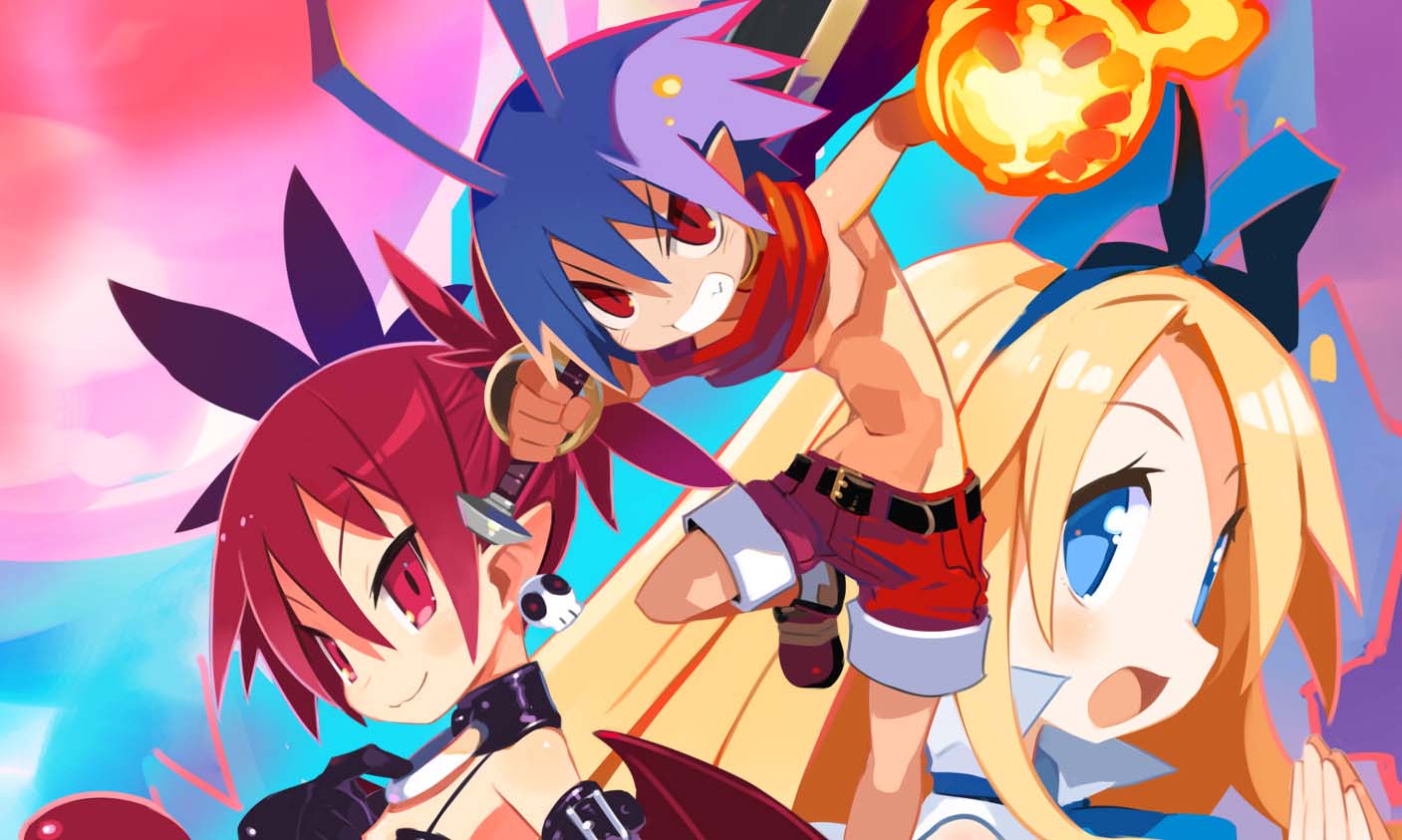The Disgaea franchise had its first steps back in 2003 on the PlayStation 2. They are RPGs that push levels into four digits, stats into hundreds of millions, enough content to replay until you die, all wrapped up in a quirky anime package. The first game, Disgaea: Hour of Darkness, is no stranger to ports and enhanced editions – having been on PSP, Nintendo DS, and PC. Now, the game has gotten a fresh coat of paint with Disgaea 1 Complete. While fans of the newer games may get a little frustrated with this one, the game is still enjoyable in spite of its shortcomings. Read on to find out more on this classic game’s remake.
Disgaea 1 Complete
Publisher: NIS America
Developer: Nippon Ichi Software
Platform: PlayStation 4, Nintendo Switch (Reviewed)
Release Date: October 9th, 2018 (US), October 12th, 2018 (EU), October 19th, 2018 (ANZ)
Players: 1 Player
Price: $49.99 RRP
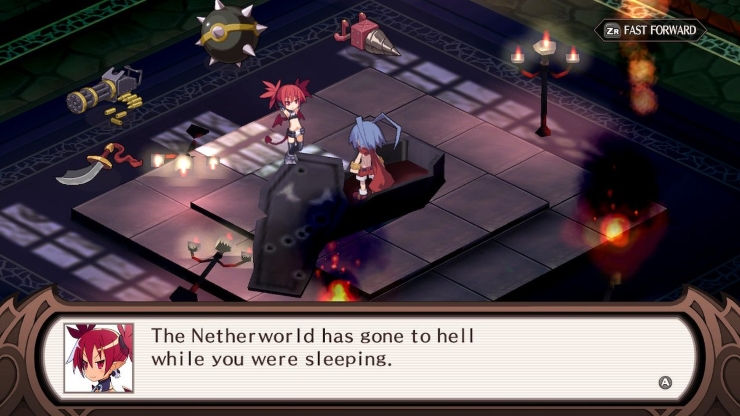
The Overlord of the Netherworld, King Krichevskoy, is dead. You play as his son Laharl, who was mid-way through a two year nap when it happened. Awakening to discover his father’s vassals and every other demon are fighting over the power vacuum, he seeks to reclaim the title of Overlord.
It is all simple stuff. Laharl gets given a reason to go somewhere, and he does so. The main characters do not really grow and mature save for the very end, and the whole thing is done with a pretty silly tone most of the time. It rarely takes itself seriously, which may make it insufferable to some, or undercut times it does try to be more serious.
Unlike other RPGs, the plot is not the focus here. Cutscenes before you go into certain stages for the first time have the option to skip it, and every cutscene has the option to fast-forward through it. While this is designed mainly for the subsequent new game + “loops” there certainly is a sense that the plot is as important here as it would be in a platformer or fighting game.
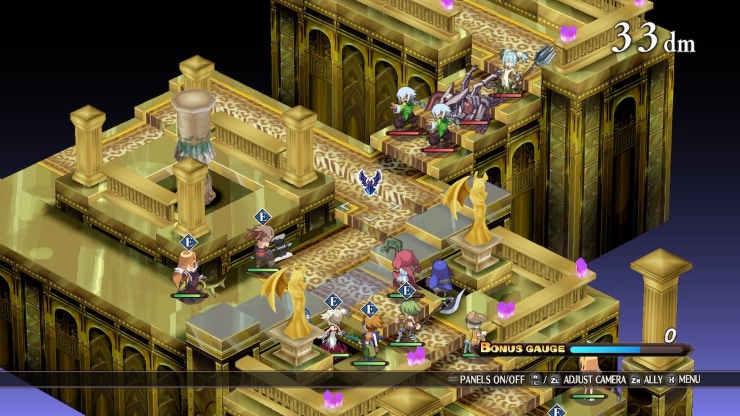
The gameplay bears a slight similarity to Tactics Ogre or Final Fantasty Tactics– An isometric grid where a squad out of your larger army can move around and attack with weapons, spells, or special attacks. This is only the barest of the basic structure though.
You can give orders to your units, then execute it all in one go. This means you can either have everyone act at once, or only a few to see how things pan out. The more things that happen in one execution, the more you can build up the “Bonus Gauge” to earn items and gear.
Some maps also have Geo Symbols and Geo Panels. If a Geo Symbol is sitting on a colored square, all squares of the same color gain its effect. Enemies becoming twice as strong, 20% damage per turn, and so on.

If you destroy a geo symbol on a panel, it turns all panels into whatever color the symbol was. This damages any units and destroys any other geo symbols standing on those tiles. This can be used to create chain-reactions that can result in a magical explosion for massive damage, and rapidly fill up the Bonus Gauge.
Outside of the main quest you also have the Item World (which is usually full of geo symbols and panels). Each item you own contains a randomly generated thirty, sixty, or one hundred floor dungeon, depending on how rare the item is (Common, Rare, and Legendary respectively).
Along with making the item more powerful by progressing deeper down, it may also contain “Innocents”- neutral NPCs that boost the stats of an item even more. Once killed they can be transferred around your other items or fused together to make even bigger stat boosts.
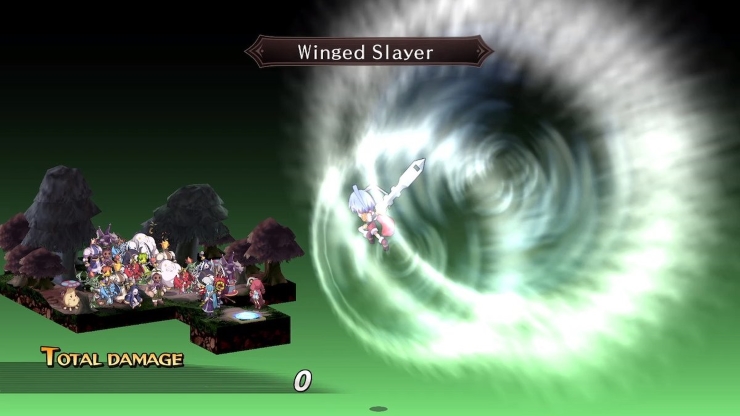
This all ties together beautifully for the main drive of the game, “smart” grinding. You are encouraged to maximize your efforts replaying specific maps that are designed for it. You can throw enemies onto each other to make a single unit with their combined levels. Do it on a map with a +100% EXP Geo Panel and whoever kills it can get a ton of experience.
You can let weaker units share the kill in a team-attack to get the same amount of experience for everyone involved. Delving into the Item World gets you more gear for everyone and makes that piece of equipment super-powerful. Everything adds up to make strong characters with strong gear.
This extends to creating new characters for your squad. While humanoids are unlocked by having various classes reach various levels, monsters are unlocked by beating them. At first they will cost an exorbitant amount of mana (earned from killing enemies), but can be made cheaper by killing more of them. The rarer ones usually only appearing once on a map, or in the Item World of rare items.
This drive to constantly make your characters stronger culminates in how the game handles new game plus. You restart from the beginning with your party intact, an ideal time to power up your foes as well. It is a game that never ends, unless you seek to get every item at every rarity and beat the most powerful boss when it is at level 9999.

There are even a few more systems on top of this, but I cannot go on any longer. If you love making your party stronger in an RPG, min-maxing, or good strategy in general, you will love the gameplay. It is a little unfair to call it a “skinner box”; as if you play correctly you will be rewarded by quickly gaining levels. Almost everything works well.
The Item World can get a bit of an ordeal. You can easily spend all day in one item, if not days by leaving every ten floors or using an item to escape. Some randomly generated floors are massive, and if you want to max out your bonus gauge to get better items, moving around geo symbols can be a pain; assuming the puzzle on that floor can be fully cleared.
While players do not need to “power-level” to succeed, they will need to grind at some points. Enemies increase about two or three levels per map, and even if you are using the same ten units over and over, you will find yourself needing to replay a map to get a few levels. Though over-levelling and using a core of six or so can help for a while.
Since the unit that kills an enemy get all the experience, this can be a real hindrance to healers. They get a pittance of experience for healing, and their attacking power is really lacking. Taking part in team-attacks alleviates this a little, but even then I found my healers often could not add any meaningful damage to the attack.
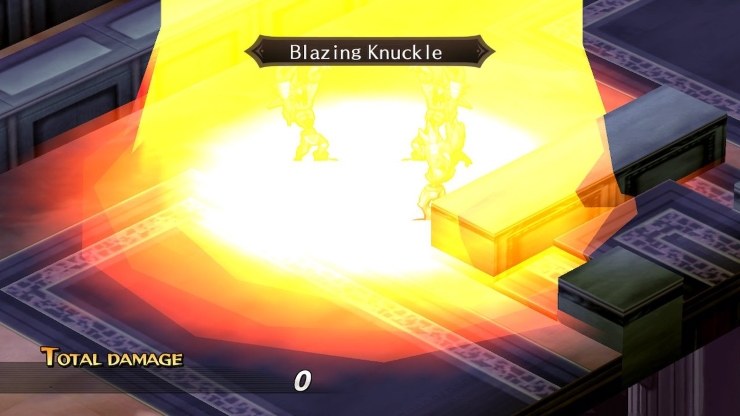
Another downside is the Mentor and Pupil system. Any character can spend its mana to create a new character- becoming its mentor. Mentors gain 10% of the stats their student does when it levels up, assuming they are using the same weapon they do at the time.
The real reason to keep an eye on who creates who is to make Team attacks between them more likely (ideal for leveling up), and to pass on spells. Pupils can (paradoxically) teach their mentors their spells. If a mentor stands next to its pupil, it can cast his spells. Do it enough times, and the mentor learns the spell for itself.
The downside is that while some mechanics are hinted at (like throwing enemies together to add their levels up), there is no clue this can happen. It can be a real pain as some units desperately need spells. This is made worse by the order you are likely to unlock certain classes. A character you get finishing Chapter 3 desperately needs to be the mentor of healers and mages for example.
Speaking of spells, out of the twenty or so monster classes you can unlock, six of them are more magic-focused. Monsters do not get staves or any other humanoid weapons, instead having their own monster weapons. None of them boost the intelligence stat. Further, items that boost Intelligence like orbs and glasses do so by a comparatively minuscule amount.
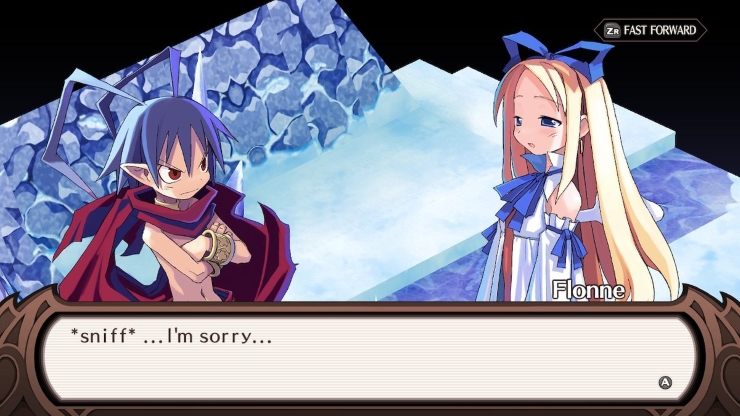
In fact, the game as a whole has kept most of the issues of the original game. Character’s moving animation is just a little bit slower than in later titles. You can turn off animations to speed things up, but you are not hold down a button during gameplay just to toggle this (to see a new attack for example); like in later titles.
While not an exhaustive list, gameplay issues include: Not being able to throw a unit onto another ally to catch and continue throwing, not able to see what skills enemies have to work out where they can hit you, how relatively strong your own skills are (damage rating F to S) or what stat they calculate their damage from.
Any characters that would have hit an enemy who is now dead also lose their action. You have no summary of what units are taking an action in which order in case you forget who is doing what. And the AI either stays put, charges at you, or waits until something is in range. It never tries baiting you or acting beyond the above.
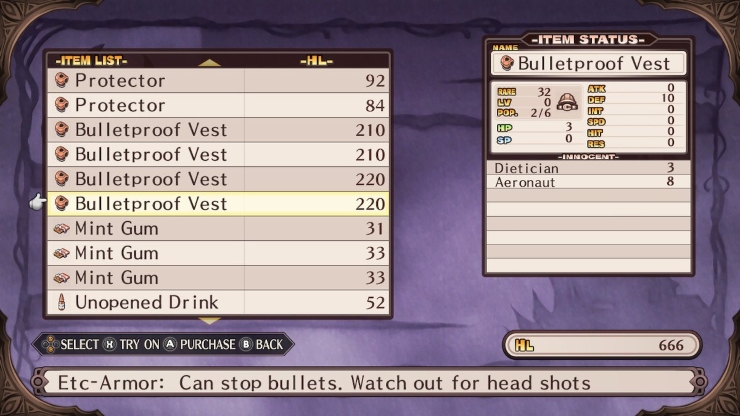
There are also minor gripes. Such as how rare and legendary items are supposed to flash to let you know they are above common, but the flashing can be very faint. Cutscenes do not have an auto-play feature to save you mashing confirm. The game does not even have a random name generator for the characters you create!
I usually champion accurate ports, and I was not expecting new mechanics from newer games. Things like rebalancing how stats and classes work is not a “mechanic”- it is as expected as improving graphics and controls. The game is still good, but it could have been great if it threw off its shackles and was a soft remaster.
In addition, NISA have developed a rather infamous reputation for their games having bugs in them. Some even being hard crashes. While keeping some bugs the original game still had (magic doing half-damage for no reason), I did get two crashs while I was playing. I was not able to replicate them, and I do not know if that is better or worse.
While listing out the negatives sounds utterly condemning, I must emphasize I was still enjoying myself. While it took me a while to get used to what this game did not have compared to later Disgaea titles, I was still having fun. It unintentionally shows how far the series has come, considering its first steps and questionable blunders.
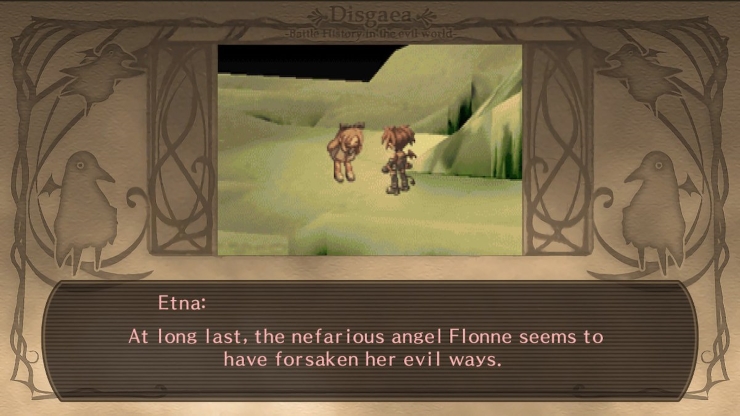
The graphics seem to utilize many assets from recent games, with the occasional new asset themselves. Most 3D objects have blurry textures, while the 2D sprites do have the slightest hint of pixilation around their borders. Disgaea 5 did not have similar issues, which is strange since many of the sprites seem to come from recent titles such as that.
By using sprites from other games, some classes have gotten a make-over. While the old art-style from the first game is long gone with updates to humanoid classes like the Skulls and Brawlers, some of the monster classes seem to use sprites of entirely different monsters.
Beasts, Shadows, Winged, Galactic Demons and Treants are replaced by Dragon Zombies, Reapers, Imps, Rifle Demons and Shrooms respectively. While these are fine substitutes based on their designs, it is annoying when monsters like Faeries, Pumpkins and Dark Knights have updated sprites. Most likely due to them being assets from Disgaea D2.
Some of the old tier names are kept, even when the class name has been changed. For example the lion-like Beasts are now skeletal Dragon Zombies. Yet with sub-classes like Manticore and Sphinx it feels lazy, rather than a reference to the original. The same with Galactic Demon’s rank of Cyclops, considering the Rifle Demon has three eyes.
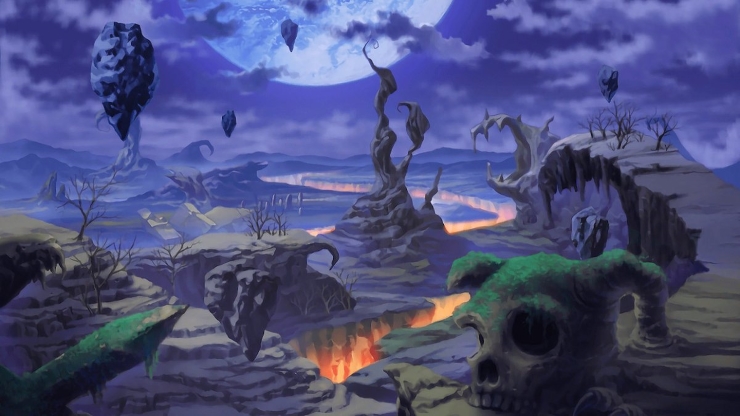
The background art is as gorgeous as it ever was, but suffers from larger screens. It can look a little muddy and blurred in places, though this is an extremely minor complaint. It still looks good, but a high-definition redrawing may have been better. Much like how the “Next Episode” preview skits do not just use the original sprites, but the original picture.
The music is still as sweeping as it ever was. It seems to be a re-recording or an updated MIDI. In either case it sounds great, and older fans are sure to appreciate the old tunes sounding better. Though they may have already heard some those tracks to death in- you guessed in- other Disgaea titles.
Apart from one sound effect in the beginning of the game (a very low quality stock fire sound effect), the sound effects are usually crisp and have plenty of impact. While the attack animations do not get as wild as (all together now) other Disgaea titles do, attacks hit with a satisfying slice, thwack, fwoosh and kaboom.
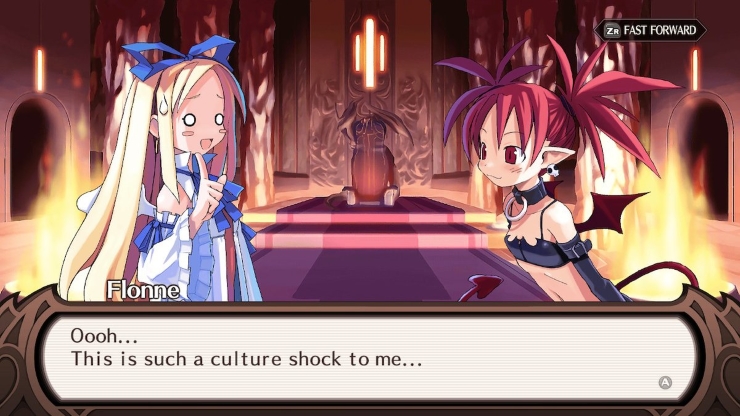
The voice work is the same as it was back with the original game (bar Etna who changed her voice actress in one of the later remakes). Despite being done in 2003, it sounds like 80s anime dub goodness. That is to say, it sounds absolutely awful.
While there are a few characters who sound good, most of the voices you hear are annoying and poorly acted. It almost sounds like someone doing a mean-spirited parody. With no mouth-movements to match the poor acting is no excuse, now and in 2003.
I came across some scenes where the dub voice acting did not happen, yet did so in Japanese. There were even times during gameplay my characters would suddenly speak Japanese, despite having the English language option on.
While the game has both Japanese and English voice acting, a full re-recording would have gone a long way. Even if you like the dub, there are times lines abruptly cut off just as the sentence finishes. Despite a few good actors and actresses, voice acting is poor overall. I recommend the Japanese audio, lest you want to hear a certain mid-boss who sounds like Kermit the Frog.
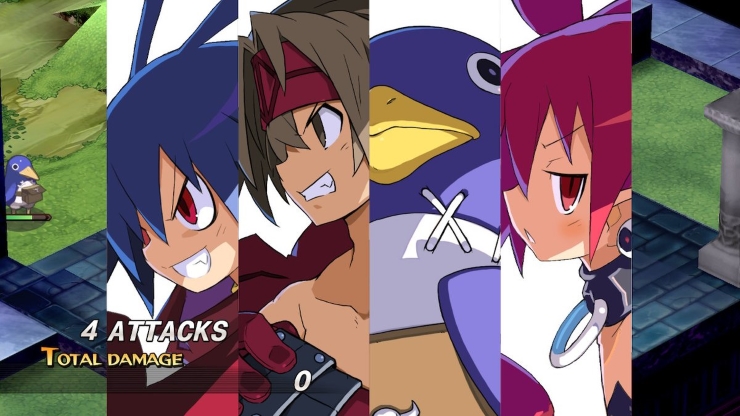
A game should be judged on its own merit, and while I have frequently said other Disgaea games have done better in various areas, I could have said that about other games outside the series. The game really shows its age and is begging for a proper remaster rather than a straight port with a new look hastily slapped together.
The biggest issue is working out who this game is meant for. Those who want to play from the first game can get Disgaea PC for the same experience (minus a few new classes) for much cheaper, and with mods for some issues. Even playing a later game with more features and improvements is fine since the plots are mostly self-contained.
If the only Disgaea game you can get is Disgaea 1 Complete, you will still enjoy yourself. It provides insane hour per dollar value if it scratches your team-building and strategy itches. You may just have to endure and work around some major issues.
To those familiar with later Disgaea games, those older problems may be anything from a minor issue to you, to incredibly frustrating. You may still get some enjoyment nonetheless. While it can be purgatory, it is far from hell.
Disgaea 1 Complete was reviewed on Nintendo Switch using a review copy provided by NIS America. You can find additional information about Niche Gamer’s review/ethics policy here.
The Verdict: 7
The Good:
- Total gameplay time is jaw-dropping.
- Surprising depth in team building.
The Bad:
- A few basic improvements from later games are sorely missed.
- Magic using monsters and healers get screwed over.
- Bad English voice acting.
- Poor quality textures on 3D assets, 2D sprites are taken from other games and clash.
